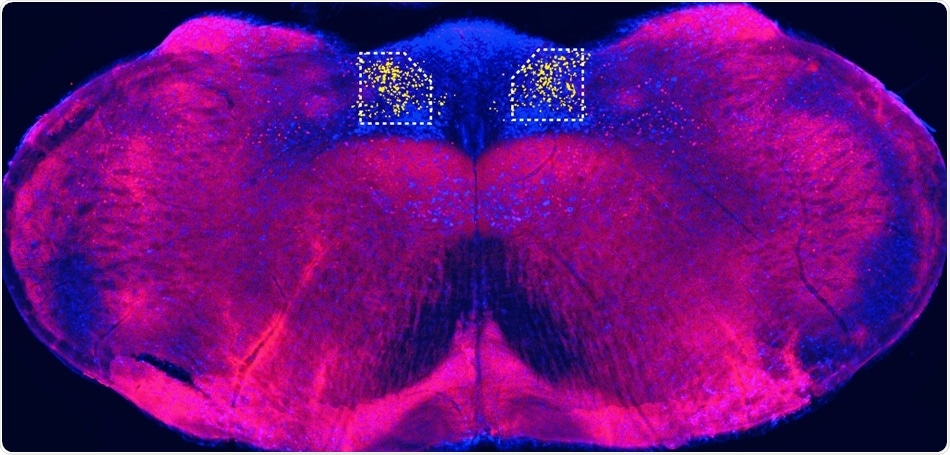A small quantity of extra sugar would be enough to make people crave for almost everything, from coffee covered in whipped cream to condiments and cookies.

A region of the mouse brain known as the cNST (colored yellow at top) responded to the presence of sugar, even if it was infused directly into the gut. Image Credit: Tan et al./Nature 2020.
However, the sweetness of sugar does not completely explain the individuals’ desire for it. Now, a new study has demonstrated that this amazing molecule has a back pathway to the brain.
Similar to other sweet-tasting things, sugar also activates the tongue’s specialized taste buds; however, it also turns on a separate neurological pathway—one that starts in the gut. Researcher Charles Zuker and collaborators from Howard Hughes Medical Institute have reported their study in the Nature journal on April 15th, 2020.
Mice experiments conducted by the researchers showed that within the intestines, signals heralding the arrival of sugar migrate to the brain, where they encourage a craving for more. But this gut-to-brain pathway seems to be picky and responds only to sugar molecules and not to artificial sweeteners.
Researchers are already aware that sugar has special control over the brain. For instance, a study carried out in 2008 had demonstrated that mice lacking the ability to taste sweetness can still show a preference for sugar.
A sugar-sensing pathway discovered by Zuker’s team can help explain why sugar is unique— and underscores ways to help suppress people’s insatiable craving for it.
We need to separate the concepts of sweet and sugar. Sweet is liking, sugar is wanting. This new work reveals the neural basis for sugar preference.”
Charles Zuker, Neuroscientist, Columbia University
Sweet stuff
Sugar is a catchall term, covering several substances that are used by human bodies as fuel. When sugar is consumed, it stimulates the reward system of the brain, rendering both mice and humans to feel good.
But in a world where there is plenty of refined sugar, this deeply rooted appetite can go berserk. The yearly sugar intake by the average American has drastically increased from less than 10 pounds in the late 1800s to over 100 pounds at present.
But the increased sugar intake has definitely come at a cost: Researches have associated the excess intake of sugar to various health problems, such as type 2 diabetes and obesity.
Earlier, Zuker’s study demonstrated that both artificial sweeteners and sugar positively regulate the same taste-sensing system. When these molecules are in the mouth, they stimulate the sweet taste receptors on taste buds, triggering signals that migrate to the brain part that processes sweetness.
However, sugar tends to impact behavior in a way that is not done by artificial sweeteners. Zuker’s research team eventually performed a test to compare the regular sugar with the artificial sweetener Acesulfame K, which is utilized in sweetening packets, diet soda, and other types of products.
When the mice were given water with sugar or with the sweetener, they initially drank both, but within a couple of days, they switched almost exclusively to sugar-based water.
We reasoned this unquenchable motivation that the animal has for consuming sugar, rather than sweetness, might have a neural basis.”
Charles Zuker, Neuroscientist, Columbia University
Sugar circuit
For the first time, the scientists identified the brain region—that is, the caudal nucleus of the solitary tract (cNST)—that responds only to sugar, and they achieved this by observing the brain activity when the mice consumed sugar against water or artificial sweetener.
The cNST, which is found in the brain stem and separate from where the mice process taste, is an information hub about the body’s state.
The scientists determined that the path to the cNST starts in the intestine lining. There, sensor molecules trigger a signal that moves through the vagus nerve, which mediates a direct information line right from the intestines to the brain.
This gut-to-brain pathway prefers one form of sugar—glucose and also analogous molecules. It, however, overlooks artificial sweeteners—which could explain why such additives do not appear to completely simulate sugar’s appeal.
The gut-to-brain pathway also ignores a few other kinds of sugar, most predominately fructose, which is present in fruits.
Glucose acts as an important source of energy for all living things, and this fact may explain how the system’s specificity for the molecule emerged, stated Hwei Ee Tan and Alexander Sisti, both study lead authors and graduate students in Zuker’s laboratory.
Earlier, the researchers had believed that the energy content, or calories, of sugar, explained its appeal since several artificial sweeteners do not contain calories.
But Zuker’s research has demonstrated that this is not the case, because glucose-like and calorie-free molecules are also capable of stimulating the gut-to-brain sugar-sensing pathway.
To gain a deeper understanding of how the brain develops an intense preference for sugar, Zuker’s team is currently analyzing the links between this gut-to-brain sugar-sensing pathway and other brain systems, such as those involved in emotions, feeding, and reward.
While Zuker’s studies are focused on mice, he believes that fundamentally, the same glucose-sensing pathway is also present in humans.
Uncovering this circuit helps explain how sugar directly impacts our brain to drive consumption. It also exposes new potential targets and opportunities for strategies to help curtail our insatiable appetite for sugar.”
Charles Zuker, Neuroscientist, Columbia University
A Gut-to-Brain Circuit Explains Why Animals Prefer Sugar
A gut-to-brain circuit explains why animals prefer sugar. Video Credit: HHMI/Charles Zuker.
Source:
Journal reference:
Tan, H-E., et al. (2020) The gut–brain axis mediates sugar preference. Nature. doi.org/10.1038/s41586-020-2199-7.